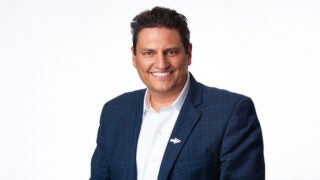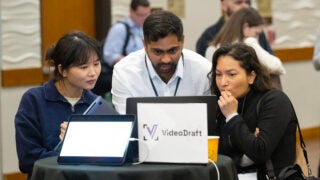Meet Your Tech Future
Get a glimpse at five ways USC researchers will change the way you live.
Raise your hand if you thought you’d have a jetpack or make your morning commute in your flying car by now. Disappointed? Don’t be. Thanks to USC researchers, other surprising ideas and innovations are poised to revolutionize our world. From implantable memory chips that help us learn faster to cybersecurity tools designed to thwart terrorist attacks, Trojan technological advances are set to become part of everyday life.
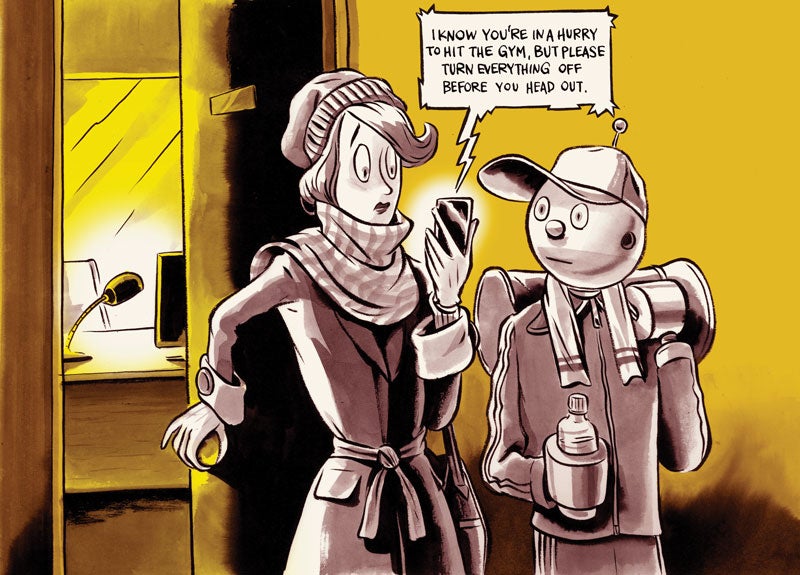
Building Buddies
On a cold winter night in 2024, it’s quitting time for Sally, a corporate attorney who works in a 25-story downtown high-rise. A frenetic whirlwind of energy, she often forgets to turn off the lights and shut down her computer. Just as Sally is about leave, a smiling avatar named Jess appears on her screen.
“Hey, Ms. Harried,” Jess jokes. “I know you’re in a hurry to hit the gym, but please turn everything off before you head out.”
Suddenly, pictures of animals in the wild, crashing waves and majestic redwoods are projected onto a screen in Sally’s office. “Do it for Mother Nature,” Jess adds.
Sally quickly turns off the lights and her computer. A text message lights up her cell phone. “Thanks, friend. Have a great night!” It’s signed “Jess”—with a smiley face.
Last week, Jess appeared as a hologram on her co-workers’ desks to remind them of Sally’s birthday, prompting an impromptu party. Sally has gotten to like Jess.
Almost everyone in Sally’s building has their own version of Jess—their own personal avatar to watch over them. The avatars, which the employees name and design, text the employees good morning, celebrate their work achievements and encourage them to save energy.
The avatars, in fact, are proxies for the building itself, which wants to forge relationships with occupants to increase their comfort and reduce the building’s overall energy usage by one-third. (Office towers and commercial buildings account for about 20 percent of all domestically consumed energy.)
“I see buildings and their occupants working together and even forming friendships,” says Burcin Becerik-Gerber, a USC Viterbi assistant professor of civil and environmental engineering. Her research on building-human interactions won her a spot on the 2012 MIT Technology Review list of the world’s top innovators under age 35.
In Becerik-Gerber’s vision, a building would use occupants’ cell phones to initiate a conversation to find out how satisfied they are with the temperature, lighting and air quality. Sensors throughout the building would capture additional data. All of this information would filter through algorithms that could recommend temperature and lighting levels for different office suites to optimize comfort and conservation. Energy wasters would receive texts, emails and audio messages to encourage them to make better choices.
Further in the future, an avatar might reward employees for making smart decisions like jettisoning a space heater or switching to two-sided copies.
Says Becerik-Gerber: “There’s a lot of room to change behaviors and save energy.”
Mechanical Minders
John doesn’t want to get out of bed.
At 79, he’s suffered a stroke that’s left him with aches and limited range of motion on his left side. If he doesn’t work on rehabilitating his left arm and leg, his doctor says, he’ll develop arthritis in the limbs on his right side from overuse.
In a perfect world, physical therapists would come to his house to help. But it’s the late 2020s, and he needs more care than he can afford. Physical therapists are in short supply too.
Thank goodness for Tiny Tim.
“Come on, John,” he says. As John reluctantly gets up, Tiny Tim moves closer to him, flashing his eyes red and green in excitement.
“Follow me,” he says, reaching and pointing with his left arm. “You can do it.
For the next half hour, Tiny Tim successfully leads John through a series of arm and leg exercises.
“I don’t know what I’d do without you, Tiny,” John says.
Tiny Tim is a robot. He and other socially assistive robots are part of the future of health care.
For the past decade, USC Viterbi’s Maja Matarić and her team of PhD students have studied how intelligent robots might provide one-to-one personalized care to assist stroke patients, people with Alzheimer’s disease and children with autism, among others.
Their pioneering work, which includes programming smart machines to be more engaging and responsive, aims to help people in need “become more self-motivated and confident to lead better lives,” says Matarić.
Matarić’s interdisciplinary team has contributed impressively to the field. In a pilot trial with stroke patients, they discovered that patients were more likely to exercise when encouraged by a robot than when alone. In studies with healthy seniors and those with Alzheimer’s, both groups strongly preferred exercising with a robot than with a computer screen. Another study tested robots that made encouraging sounds and blew bubbles whenever children with autism moved closer and interacted with them. Some children reacted so well to the robots that they talked more and turned to their parents to describe events as they occurred, a surprising feat among children who struggle to communicate.
“In 10 years,” she adds, “I hope that we will see specialized, socially assistive robot technologies enhancing human care…”
Now Matarić’s team, in cooperation with Children’s Hospital Los Angeles, is examining whether children receiving intravenous injections experience less pain if empathetic robots comfort them beforehand.
To date, no one has run large-scale clinical trials with these types of robots, largely because of the lack of funding for such “demanding yet crucial assessments,” Matarić says.
“In 10 years,” she adds, “I hope that we will see specialized, socially assistive robot technologies enhancing human care to help children with autism learn specific communication or social skills, help elderly people feel less lonely through games and conversation, and help stroke patients have the support and motivation around the clock that is needed for the rehabilitation process.”
Digital Doubles
With the Pacific Ocean as a backdrop, the familiar faces slowly make their way toward a stunning Malibu beach house.
The camera lingers on each of them, bringing smiles of recognition to excited filmgoers watching the screen. Jet Li appears first. Then Dolph Lundgren. Next is Sylvester Stallone, who smiles and hugs his comrades. The Expendables are back together, 40 years after their last movie adventure—in 2014.
They haven’t aged a day.
New members materialize. A youthful John Wayne, wearing his trademark cowboy hat, saunters up. “Howdy, partner,” he says. A young Marlon Brando, circa A Streetcar Named Desire, nods his head at the assembled. Hollywood’s latest heartthrob, Bobby Whitfield III, enters, looking resplendent in a black Italian suit. “Now, let’s get this party started,” he quips.
Incredible, yes. Impossible, no. At least not according to Paul Debevec.
Debevec is the Academy Award-winning chief visual officer at the USC Institute for Creative Technologies. The photorealistic digital faces he and his research team have created—which seem lifelike in any lighting condition—have appeared in such blockbusters as Gravity, Avatar and The Curious Case of Benjamin Button. Most recently, Debevec and his colleagues took high-resolution scans of the cast of Maleficent to create computer-generated pixies and a “digital double” for star Angelina Jolie that was used in some of the film’s more dangerous stunts.
A computer scientist with a PhD from UC Berkeley, Debevec is perhaps best known for inventing the Light Stage, a spherical, computer-controlled lighting apparatus now in its 11th iteration. With 12,000 light-emitting diodes and seven high-definition cameras, the Light Stage allows actors to be photographed under any color, intensity, polarization and distribution of light, providing the data to create photorealistic digital doubles.
So how does he think The Expendables might get made in the future? To resurrect Wayne, Brando and other long-deceased actors, computer-vision algorithms would analyze hundreds of frames from old movie footage to compute 3-D images of their faces. Actors like Li, Lundgren and Stallone could be preserved at their current ages by being scanned at the Light Stage to create digital doubles for future use. The digital faces could be composited onto the bodies of contemporary actors who could mimic the stars’ movements, while impressionists could imitate their voices. Will filmmakers and audiences balk at the casting of deceased actors’ digital doubles? That remains to be seen, but the technology will likely make it possible.
That’s not all. Debevec believes digital entertainment technology will one day allow directors to cast whomever they want in a movie—living, dead or invented.
“I like the idea of a filmmaker saying, ‘This is what I want a person to look like,’ and telling a computer, ‘This is how I want their eyes to be, how many freckles I want,”’ he says. “This could be a whole new way of applying the skills and talents of a casting director.”
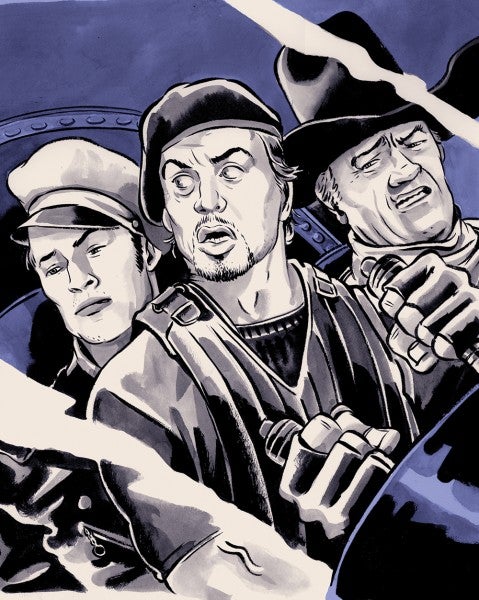
It’s a typical November night in the City of Angels in 2025.
The freeways, Metrolink trains and Metro railcars teem with commuters. Overhead, 1,500-seat jumbo jets take off and land at Los Angeles International Airport in quick succession, a precisely choreographed ballet of technology. Elsewhere, telecommuting moms and dads check email and wrap up virtual conference calls on their tablets, smartphones and watches.
At 7:58 p.m., disaster strikes.
Within seconds, a multipronged cyberattack takes out the local air traffic control system. Terrorists knock out Metro’s communications network, derailing trains. Hacked Department of Water and Power (DWP) computers shut off water to local residents and release millions of gallons into the ocean. The power grid is knocked out. Then the region’s Internet goes down.
Los Angeles grinds to a halt.
Far-fetched? Maybe not. In 2012, an Al Qaeda video called for an “electronic Jihad” against the United States. The next year, federal agents warned more than 3,000 companies that they’d been hacked, according to White House officials. And in September, a cyberattack reportedly exposed information on more than 27,000 U.S. government employees.
Given cyberterrorists’ increased sophistication and the defensive nature of cyber warfare—bad guys need only find and exploit system vulnerabilities, while those under attack must protect entire networks—the risk of a cyber Pearl Harbor has never been greater.
“While cyberthreat growth continues to accelerate, the stream of new and effective cyberdefense technologies has grown much more slowly,” Terry Benzel said before Congress in 2013. As deputy director for the Computer Networks Division at USC’s Information Sciences Institute (ISI), she went to Washington to address lawmakers about ways to improve cybersecurity research, including better technology transfer between academia and industry.
Benzel, a renowned cybersecurity expert and former division vice president of the antivirus company McAfee Inc., has spent the past decade at ISI leveling the playing field.
Under her direction, USC, in cooperation with UC Berkeley and private partners, built DeterLab. The nation’s largest and most advanced university-managed test bed supports research and development on next-generation cybersecurity
technologies. More than 200 organizations, including the Pacific Northwest National Laboratory and Columbia University, use the platform, which is largely funded by the Department of Homeland Security.
How might DeterLab help thwart large-scale cyberterrorism?
Entrepreneurs and researchers could develop powerful anti-malware software within this sealed-off mini-Internet by launching and learning from simulated cyberattacks on critical American infrastructure, including power grids, financial systems and transportation networks.
Within a decade, Benzel hopes DeterLab could link with other test beds to create specialized environments in which agencies like LA’s Metro and DWP could “take advantage of the tools and protocols we’ve developed to create new technologies to repulse attacks,” she says. “We need an ecosystem of test beds connected together for research on the hard problems facing us.”
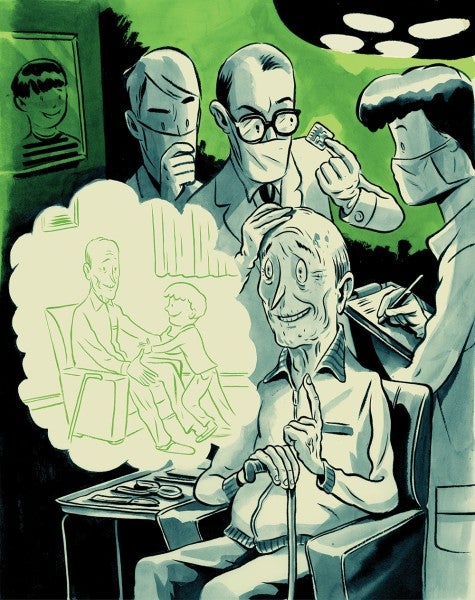
Making Memories
Madeline, an 85-year-old grandmother, enters a classroom. The French teacher, a tall, beret-wearing robot named Jacques, immediately moves to kiss her on both cheeks.
“Comment allez-vous?” he asks. The elderly woman smiles at Jacques, who has taught her French for the past few months. Today, Monsieur Robot discusses how to conjugate regular verbs into the subjunctive tense, which expresses uncertainty, doubt and possibility. Complex stuff.
Back in the day, in the 2010s, even the most dedicated French students struggled with the subjunctive and its nuances. No more. Madeline has no problem mastering French’s many linguistic complexities. She’s also recently learned calculus and Spanish with relative ease.
People used to grow more forgetful and less sharp with age. Memories of yesteryear sometimes lost their vividness or disappeared altogether. The situation was worse for people whose brains were damaged from stroke, injury or dementia. These people often failed to create new long-term memories, making it difficult to remember caregivers’ names, how to dress or even how to find the bathroom.
So what changed to allow seniors to learn foreign languages as easily as their grandchildren? How could people with brain injuries make new long-term memories?
Perhaps it was because a brain implant now in development by USC Viterbi professor Ted Berger eventually went mainstream.
“In the future, we expect that the chip will help many people have better and stronger memories,” says Berger, whose chip was dubbed a “breakthrough technology” by MIT Technology Review in 2013.
A renowned neuroscientist and biomedical engineer, Berger has worked for more than 15 years on an implantable silicon microchip that could help patients with severe memory problems form long-term memories again. The chip, which would be placed under the skin at the crown of the skull, might one day also improve the memories of healthy people.
Berger’s neural prosthesis, which he has developed with an international team of computer scientists, engineers and physicians, would boost a damaged hippocampus—the region of the brain where long-term memories are made. The chip would act as a bridge across damaged brain tissue to help short-term memories become long-term ones.
The chip translates short-term memories into the proper codes as they travel through the hippocampus. In successful pilot trials, researchers have even recorded memories as they occur. Large-scale clinical trials could happen within a year.
Berger’s fervent commitment to developing the world’s first memory chip is personal. A series of strokes left his mother unable to make any new memories. He felt helpless watching her mind waste away. His team’s chip could greatly benefit people like her—and perhaps the entire population.
“It theoretically could make people smarter, give them more detailed and vivid memories that fade away not in two years but in 10 years,” Berger says. “The chip might make people better at math and spelling and allow them to make associations to come up with new ideas, unique things.”

